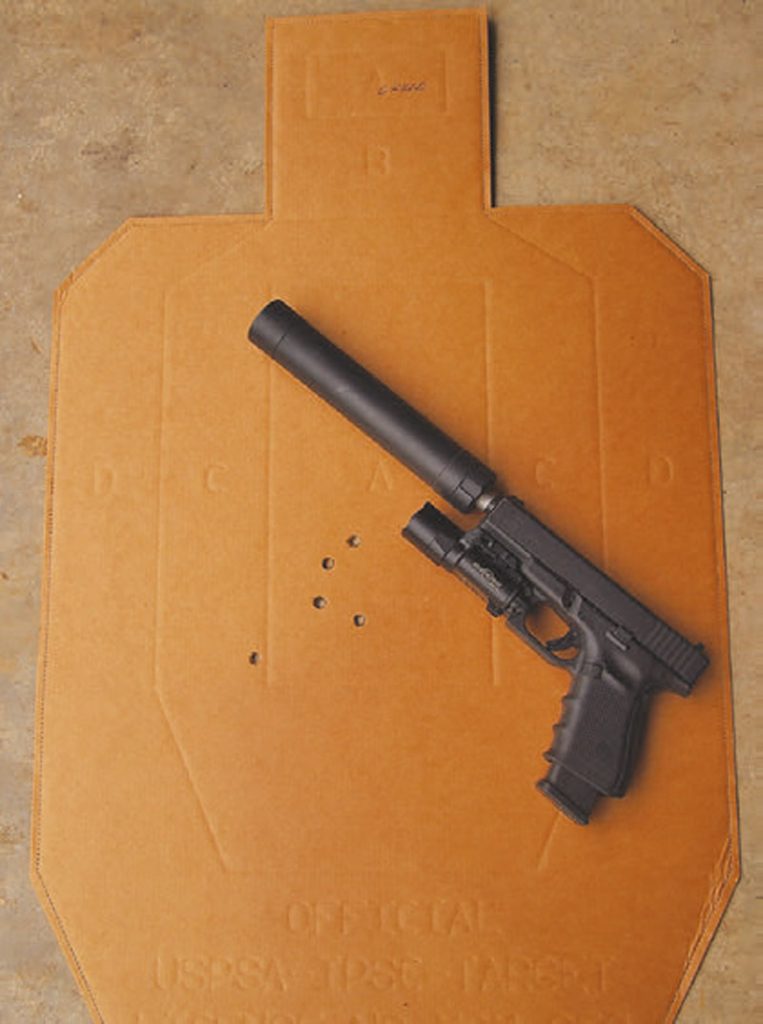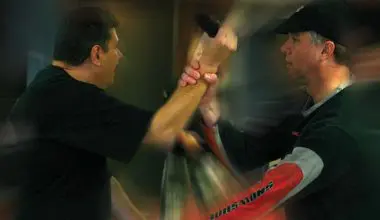
Outfitting your home-defense gun with a sound suppressor is an approach worthy of serious consideration. Defense against a home invasion will likely be a very short duration affair. You won’t have time to grab hearing protection, and firing multiple rounds out of a serious handgun (much less a rifle, but that’s a different topic) inside an enclosed dwelling can lead to permanent hearing damage.
The sound suppressor (often referred to as a “can”) is an obvious remedy to this dilemma. The problem is that on an auto-pistol, the top of the suppressor body rises up considerably above the height of typical sights. You won’t be able to aim the gun unless you have “suppressor sights”—extremely tall front and rear sights designed to be visible over the suppressor body.
Or will you?
In this article, I will detail three techniques that do not require suppressor sights for aiming a suppressed auto-pistol.
Few auto-pistols come out-of-the-box with a barrel threaded for a suppressor. Therefore you need to buy one. The good news is that, for numerous pistols from several major manufacturers, a replacement threaded barrel does not require fitting. It’s a drop-in unit.
For most people, just buying a suppressor is a significant outlay of cash ($1,000- plus) especially if the host handgun didn’t include an appropriately threaded barrel. It also requires jumping through federal Class III hoops and paying additional money to get licensed.
Let’s assume you’ve done all that, because you really want a suppressor for your home-defense gun.

Table of Contents
GUN CHOICE
Certain suppressor designs, like the Silencerco Osprey and AAC (Advanced Armament Corp) Evolution, are “eccentric” in design, meaning the suppressor is oval or rectangular and when installed, the “short” side of the suppressor faces up, specifically so you can use standard sights. Most suppressors are “concentric”: the barrel is centered in the circular suppressor body, like the AAC TiRant and Silencerco Omega 9k. With those designs, standard-height iron sights will not clear the suppressor body.
My preferred defensive handgun is the Glock 19 Gen4. I have two of them, one for carry and one dedicated to home defense. This way I don’t have to pull the suppressor off my home-defense gun every time I leave my home, turning it into a carry gun, then reinstall it before I go to bed so it magically turns into a home-defense gun.
For home defense, the threaded-barrel G19 wears an AAC TiRant. I didn’t want to put suppressor sights on this gun for a couple of reasons.
First, this would change the height at which I had to mount the gun to fire. With suppressor sights, I’d need to hold the gun considerably lower than with standard irons to aim it, and vice versa.
Second, it is not beyond the realm of possibility I might need to pull the suppressor off the gun and use it as my concealed-carry piece should my primary-carry G19 break or for some other reason be unavailable. I didn’t want sights so high the gun wouldn’t fit in a standard holster.
Smith & Wesson, SIG, HK, Glock, Kimber, and a few others offer handguns already equipped with threaded barrels. If your gun is from a major manufacturer and doesn’t have a threaded barrel out-ofthe- box, you can probably get one anyway. SIG has them available on their website. A factory Glock threaded barrel may be had through Gemtech, and aftermarket barrels are available from various makers.
WORKING WITHOUT SUPPRESSOR SIGHTS
Some of these units come complete with suppressor sights tall enough to clear the suppressor body. Many of them do not. If you don’t have suppressor sights, you have three options:
- Use a slide-mounted mini red dot sight (MRDS). The dot rides high enough to clear the suppressor body. Unfortunately, this approach tends to result in pistol downtime while it’s sent out for machining the slide to accept an MRDS, unless an aftermarket already-machined slide is purchased. This option gets pricey fast.
- Buy suppressor-height sights. This is a viable option, but you may already have some nice tritium sights. Buying them wasn’t all that cheap to start with … do you really want to pull them off the gun? Also, the sights you like may not be available in a suppressor height. A good example is my preferred AmeriGlo CAP sights.
- Learn how to use standard-height sights with the suppressor.
I began going this final route because I wanted to keep my sights the same height across all the auto-pistols I might use for home defense or concealed carry. I generally use one of a few Glock 19s, but I recognize there are many other great handguns.
I have found three techniques that work well with standard- height sights on a suppressor-equipped Glock 19. The first I use for faster shooting up close: the Cirillo Silhouette Point (though I’m not sure the late Jim Cirillo ever envisioned his technique being used with suppressors). The second is the Bindon Aiming Concept. The third is shooting “through” the suppressor.


CIRILLO SILHOUETTE POINT
The Silhouette Point was developed by Jim Cirillo of the famed NYPD Stakeout Unit. Jim felt that using the sights in self-defense might slow the shooter down, but he also didn’t advocate unsighted fire. What he came up with was the idea of using the silhouette of the gun itself—in essence one very large sight.
The silhouette of a gun changes—if it’s pointed to the left or right, it gets significantly wider. To learn the Silhouette Point, first make sure you remove the magazine from your gun, then clear the chamber. Place all ammunition in a different room. Now, with the suppressor affixed to the gun, find a safe direction and a safe target.
Open both eyes and look at the rear of the gun and get a sense of its overall shape—its silhouette. Shift the gun/suppressor to one side or the other, and you’ll see that the shape of the silhouette changes. Start out using the sights to verify gun alignment while learning Silhouette Point, then progress to placing a piece of tape over the rear sight notch so you can’t “cheat” by using the sights. Learn to use only the silhouette of the gun, not the sights, to align it.
Jim felt the Silhouette Point was not unaimed fire or point shooting. Rather than using your eyesight to consciously pick up the sights, by focusing on the shape of the gun instead, you free your mind to subconsciously pick up the iron sights. The subconscious mind is capable of working much faster and more flawlessly than the conscious mind.
In my experience, Silhouette Point is a quick ‘n’ dirty technique that with practice works well for fast center-mass shots inside ten yards or so.
BINDON AIMING CONCEPT
If you need finely aimed fire and/or are shooting at longer distances (ten-plus yards), this is where occluded-eye shooting comes in. The occluded-eye concept typically refers to covering over a dot optic on a rifle and shooting with both eyes open, taking advantage of our natural binocular vision.
You pick up the dot with one eye, your other eye picks up the target, and your brain superimposes the two so what you see is a dot on the target. The basic concept of occluded-eye sighting has been in use on mortars and various field guns since World War I.
In years past, Trijicon produced a sight for carbines using this idea, which they called the Bindon Aiming Concept (BAC), named for the late Glyn Bindon, the founder of Trijicon. We will borrow this technique and apply it to handguns.
As before, start with all ammo removed from the gun and placed in another room. Next, determine a safe direction for pointing the gun. Close your non-dominant eye (the one you don’t use for sighting) and acquire your sights with your dominant eye.
This is where having a very visible front sight comes into play. I use the AmeriGlo CAP front sight, which is bright yellow on its face and shows up well against the black rear of the suppressor body. Now, open the non-dominant eye. Suddenly you can “see through” the suppressor body. Your mind will automatically merge the two images, and you’ll see a sight picture over the target. Now you can acquire a sight picture using both eyes and still be able to aim effectively.
Using this technique and my suppressor-equipped Glock 19, I’ve found head shots on a USPSA target at 15 yards to be no real challenge.

SHOOTING THROUGH THE SUPPRESSOR
The major problem with shooting any auto-pistol equipped with a suppressor and standard-height sights, if the front and rear sights are black-on-black, is that you lose a black sight picture against the black back of the suppressor body.
Thus I have equipped my Glock 19 with the previously mentioned AmeriGlo CAP front sight, the bright yellow face of which stands out well against the black suppressor body. To “shoot through the suppressor,” I simply use a standard sight picture, put that where I want the bullets to go, and just ignore the suppressor. Again, we practice this extensively in dry fire before we ever progress to doing it with live ammo on the range.
In my experience, this technique is considerably more accurate than the Silhouette Point in close-range, fast-andfurious shooting: an apple-sized group versus having all the bullet holes somewhere in center mass. It doesn’t require learning any new shooting technique. You just do everything as you’re used to doing with normal sighted fire.
This is the simplest approach to shooting a suppressorequipped auto-pistol with normal-height sights. Simple is good.
When using this technique, there can be a tendency to aim using the sights, but still lower the gun enough you can see where you want the bullets to go over the top of the suppressor. This leads to shots being well centered for windage but a bit low. You can see this in the target photo for shooting through the suppressor. This tendency can be overcome with practice, but it’s something to be aware of.
SUMMARY
Depending on the shooter, one of these techniques may work better than the others. Everyone’s mind and body are different. Experiment and find what works best for you. Know different techniques to deal with different situations. There is no “one size fits all” approach for everything that could possibly happen.
Using a suppressor-equipped auto-pistol with non-suppressor height sights is not impossible, nor is it even particularly difficult. You just have to know the right techniques.





